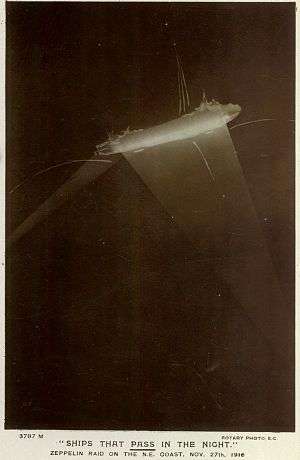Zeppelin LZ 76
The Imperial German Army Zeppelin LZ 76 (L-33) was a R-class World War I zeppelin.
| LZ 76 (L 33) | |
|---|---|
.jpg) | |
| Imperial German Army Zeppelin LZ 76 brought down near a cottage in Essex | |
| Role | R-class reconnaissance-bomber rigid airship |
| National origin | German Empire |
| Manufacturer | Luftschiffbau Zeppelin |
| Designer | Ludwig Dürr |
| First flight | 30 August 1916 |
| Primary user | Imperial German Navy |
| Number built | 1 |
| Unit cost |
DM2,800,000[1] |
Operational history
On 23 September 1916 a bombing raid was planned for London. That night, a Zeppelin group (LZ 72 [L 31], L 32, L 33 and L 34) set out to complete the mission. They succeeded in dropping 3,200 kilograms (7,100 lb) of bombs on London and surrounding counties. On its first mission, anti-aircraft damaged LZ 76 its commander Kapitan-Leutnant Alois Bocker changed its course over Essex. It was here that the airship was attacked by 39 Home Defence Squadron night fighters from Hainault Farm. RAF officer Alfred Brandon was flying a B.E.2e fighter when he attacked Zeppelin LZ 76, helping to bring the airship down in a field.[2] Even after dropping guns and equipment, Bocker calculated that the ship would not make it safely across the North Sea, and he landed in Little Wigborough, Essex, the morning of 24 September 1916 with no fatalities. Right away, the crew set out to destroy the airship but were only partly successful in burning the hull.[3]
British engineers examined the skeleton and later used the plans as a basis for the construction of airships R33 and R34.
Specifications (LZ 76 / Type R zeppelin)



Data from Zeppelin: rigid airships, 1893–1940[1]
General characteristics
- Crew: 17-19
- Capacity: 32,400 kg (71,430 lb) typical disposable load
- Length: 198 m (649 ft 7 in)
- Diameter: 23.9 m (78 ft 5 in) maximum
- Fineness ratio: 8.24
- Volume: 55,200 m3 (1,950,000 cu ft) in 19 gas cells
- Empty weight: 31,400 kg (69,225 lb)
- Gross weight: 32,908 kg (72,550 lb)
- Fuel capacity: 6,250 kg (13,779 lb)
- Useful lift: 63,800 kg (140,700 lb)
- Powerplant: 5 × Maybach HS Lu 6-cylinder water-cooled in-line piston engines, 180 kW (240 hp) each
- Propellers: 4-bladed Lorenzen fixed-pitch propellers
Performance
- Maximum speed: 103 km/h (64 mph, 56 kn)
- Cruise speed: 81 km/h (50 mph, 44 kn)
- Range: 7,400 km (4,600 mi, 4,000 nmi) at 81 km/h (50 mph; 44 kn)
- Service ceiling: 3,900 m (12,800 ft) static
- Rate of climb: 10 m/s (2,000 ft/min) maximum permitted (r-class)
Armament
- Guns: machine-guns in hull-top positions and gondolas
- Bombs: up to 60 bombs to a total of 5,000 kg (11,023 lb)
Zeppelins shot down over the UK
Airships made about 51 bombing raids on Britain during the war. These killed 557 and injured another 1,358 people. More than 5,000 bombs were dropped on towns across Britain, causing £1.5 million in damage. 84 airships took part, of which 30 were either shot down or lost in accidents.[4]
| Zeppelins shot down over the UK | ||||||||||||||||||||||||||||||||||||||||||||||||||||||||||||||||||||||||
|---|---|---|---|---|---|---|---|---|---|---|---|---|---|---|---|---|---|---|---|---|---|---|---|---|---|---|---|---|---|---|---|---|---|---|---|---|---|---|---|---|---|---|---|---|---|---|---|---|---|---|---|---|---|---|---|---|---|---|---|---|---|---|---|---|---|---|---|---|---|---|---|---|
|
Bibliography
Notes
- Brooks, Peter W. (1992). Zeppelin: rigid airships, 1893–1940. Washington, D.C.: Smithsonian Institution Press. pp. 95–99. ISBN 1560982284.
- Classen 2017, pp. 220–222.
- Guttman 2018, p. 70.
- Liddell Hart, Sir Basil Henry (1934). A History of the World War 1914-1918. Faber. p. 76. ISBN 9780304936533. - Total pages: 635
References
- Classen, Adam (2017). Fearless: The Extraordinary Untold Story of New Zealand's Great War Airmen. Massey University Press. ISBN 9780994140784.CS1 maint: ref=harv (link)
- Guttman, Jon (2018). Zeppelin vs British Home Defence 1915–18. Bloomsbury Publishing. ISBN 9781472820341.CS1 maint: ref=harv (link) Total pages: 80



